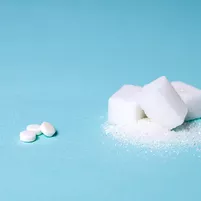Sweeteners


Sweeteners or sugar substitutes are food additives used to give a sweet taste to foods and beverages such as soft drinks, desserts, dairy products, sweets, chewing gum, and low-calorie and weight control products.
Some sweeteners such as aspartame or sucralose are many times sweeter than sugar.
Sweeteners can be produced in different ways such as by extraction from plants (for example, steviol glycosides or thaumatin) or from other materials of vegetable origin (for example, neohesperidin DC, derived from citrus).
They can also be synthesised (for example, saccharin) or obtained using microorganisms in the production process (for example, erythritol sugar alcohol (polyol), also referred to by number E 968, used as a sweetener).
Some common substances with a sweet taste are not considered sweeteners under EU regulation. This list includes, for example, monosaccharides, disaccharides or oligosaccharides and foods containing these substances used for their sweetening properties.
Other sweet substances intended as sugar replacers that were not consumed to a significant extent prior to May 1997 are assessed separately as novel foods.
As for all food additives, new sweeteners must undergo a safety evaluation prior to market authorisation in the European Union (EU).
EFSA’s scientists are currently re-evaluating the safety of all sweeteners that were already permitted for use in foods before 20 January 2009.
The presence of a sweetener must be indicated on the label of a food or drink either by its name or its E number A number used in the European Union to identify permitted food additives. An E number means that an additive has passed safety tests and has been approved for use.
Latest
The following table lists the sweeteners authorised for use in the EU and the status of EFSA’s respective safety assessments. EFSA’s ongoing re-evaluations can be tracked via our public tool Open EFSA.
| E number | Name | EFSA's assessment |
|---|---|---|
| E 420 | Sorbitols | Re-evaluation ongoing |
| E 421 | Mannitol | Re-evaluation ongoing |
| E 950 | Acesulfame K | Re-evaluation completed in 2025 |
| E 951 | Aspartame | Re-evaluation completed in 2013 |
| E 952 | Cyclamates | Re-evaluation ongoing |
| E 953 | Isomalt | Re-evaluation ongoing |
| E 954 | Saccharins | Re-evaluation completed in 2024 |
| E 955 | Sucralose | Re-evaluation ongoing |
| E 957 | Thaumatin | Re-evaluation completed in 2021 |
| E 959 | Neohesperidine DC | Re-evaluation completed in 2022 |
| E 960a | Steviol glycosides from Stevia | First evaluated in 2010 |
| E 960c | Enzymatically produced steviol glycosides | Evaluated in 2019 |
| E 960d | Glucosylated steviol glycosides | Evaluated in 2022 |
| E 961 | Neotame | |
| E 962 | Salt of aspartame-acesulfame | Re-evaluation ongoing |
| E 964 | Polyglycitol syrup | Evaluated in 2009 |
| E 965 | Maltitols | Re-evaluation ongoing |
| E 966 | Lactitols | Re-evaluation ongoing |
| E 967 | Xylitol | Re-evaluation ongoing |
| E 968 | Erythritol | Re-evaluation completed in 2023 |
| E 969 | Advantame | Evaluated in 2013 |
Milestones
2024
December
EFSA publishes the revised protocol for assessing exposure Concentration or amount of a particular substance that is taken in by an individual, population or ecosystem in a specific frequency over a certain amount of time to sweeteners.
2023
April
EFSA publishes a revised protocol on hazard identification The first step in risk assessment, this involves the identification of biological, chemical, and physical agents capable of causing adverse health effects and hazard characterisation The second step in risk assessment, this involves defining the nature of the adverse health effects associated with biological, chemical and physical agents which may be present in food. The process should, if possible, involve an understanding of the doses involved and related responses of sweeteners to take into account revisions made during the implementation phase of the original protocol approved by EFSA’s FAF Panel on 17 January 2020.
2021
November
EFSA requests additional information from interested parties and publishes a call for technical data on sucralose (E 955) and a call for technical data on saccharin and its sodium, potassium and calcium salts (E 954).
June
EFSA requests additional information from interested parties and publishes a call for genotoxicity data on sweeteners.
August
EFSA publishes a protocol for assessing exposure to sweeteners.
February
EFSA publishes a protocol for the assessment of hazard identification and characterisation of sweeteners.
2019
December
EFSA holds a meeting with stakeholders on the two draft protocols detailing the approach and the methodology that will be followed for the ongoing re-evaluation of authorised food additives, under Regulation (EC) No 257/2010.
May
EFSA requests additional information from interested parties on the characterisation of the particle size of substances when used as food additives. Data were also requested for the salt of aspartame-acesulfame (E 962).
2018
2017
EFSA publishes a call for technical and toxicological data on sweeteners.
2016
EFSA publishes a statement on the validity of the conclusions of a mouse study on the carcinogenic potential of sucralose (E 955) performed by the Ramazzini Institute.
EFSA's role
EFSA assesses the safety of sweeteners in the same way as for other food additives. See our topic page on food additives.
In the area of health claims, EFSA has also evaluated a number of claims of beneficial health effects for consumers related to sweeteners.
EU framework
Under EU legislation, all additives including sweeteners, must be authorised before they can be used in foods.